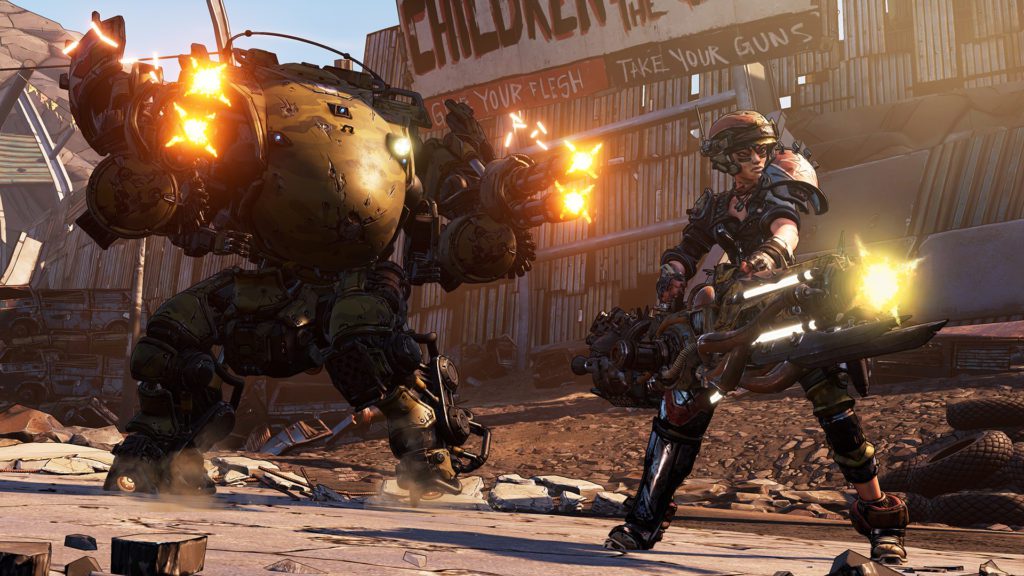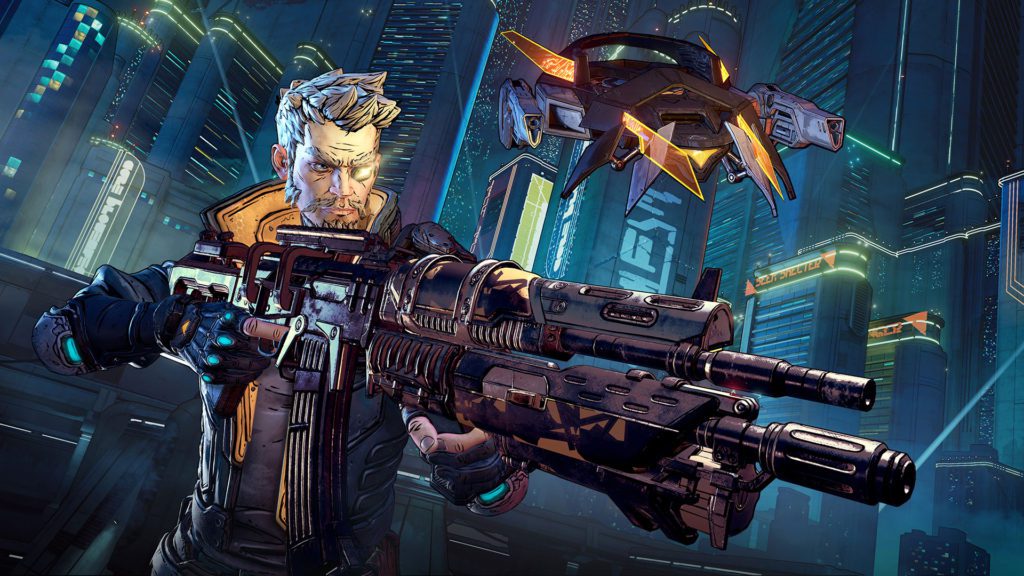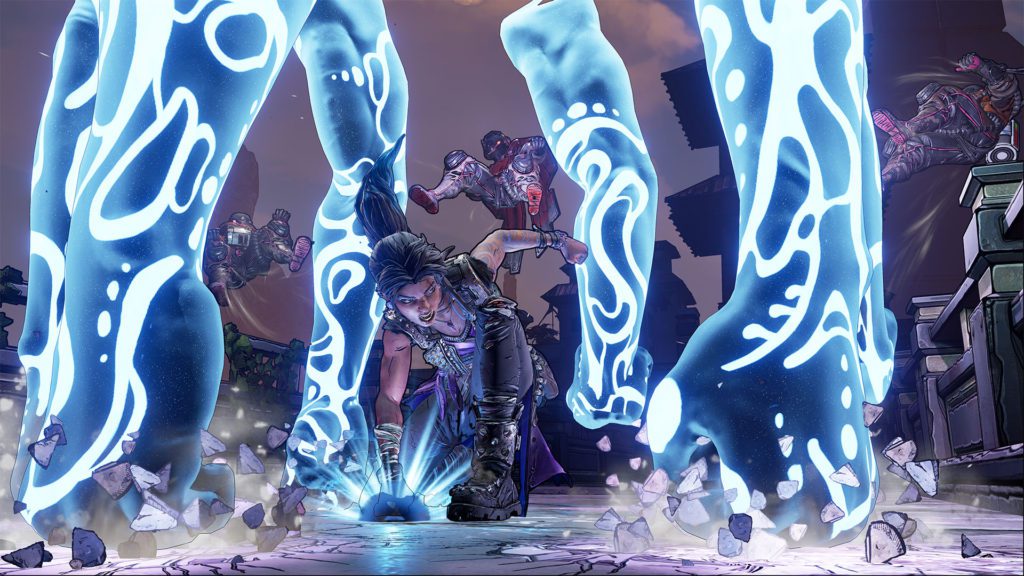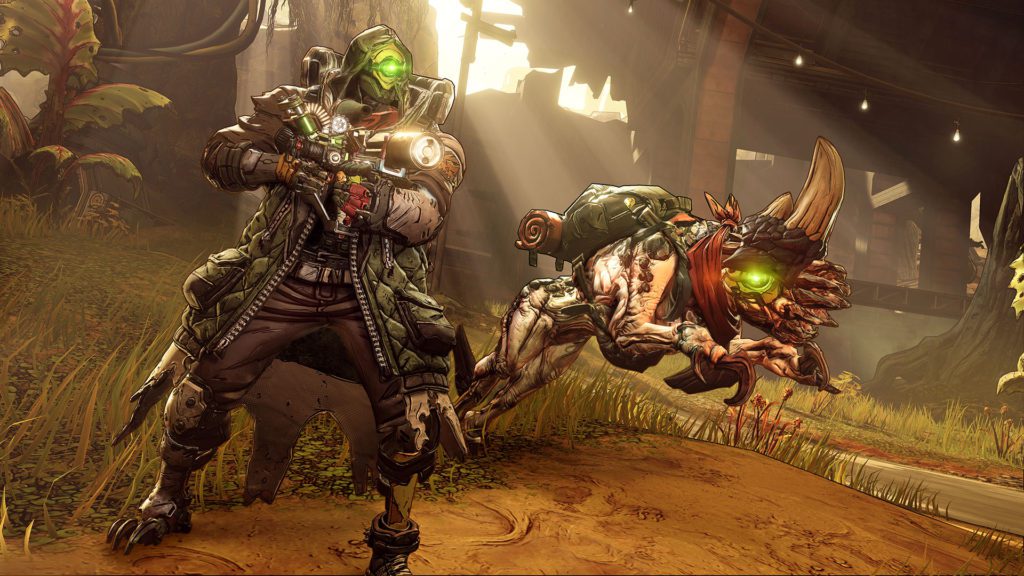Accompanying Borderlands 2 and its post-launch content was a distinct sense of finality. Jack was dead, and as the map pilfered from his pockets indicated, there was far more out there that we had yet to see. For the first time, what laid beyond the borders Pandora and Elpis had been made visible, the two infinitely smaller when measured against the vastness of faraway stars and innumerable galaxies. The finale of Borderlands 2 had closed the book on another volume of vault hunting, though it wasn’t the only point of conclusiveness that its story had detailed. Addendums to the tale of Jack could be found in the memorialising of Roland within the ‘Dragon’s Keep’ DLC, and then in the destruction of your home as depicted in the ‘Fight for Sanctuary’. There was nothing left to tie us to Pandora, and as Borderlands 3 commences, it isn’t too long before you’re plucked from its surface and ferried into orbit aboard a starship.
Escaping the confines of Pandora and exploring somewhere completely new was immediately rejuvenating. It begins on Promethea, a crystal utopia built upon an empire of bullets. From there, the tranquil monasteries of Athenas, the backwood marshes of Eden-6 and the echoing stone-ways of Nekrotafeyo await—four sizeable game-spaces that each divide into several smaller areas. And not only are they larger than the average Pandoran region, but they’re much more visually captivating. On one planet, glistening lasers reverberate beneath a neon skyline as a corporate war rages below, while on another, peace is interrupted only by the guttural groans of the watchful monsters lurking in the thicket. Borderlands 3 utilises a diversity in aesthetic that also assists in balancing its pacing, with sequential planet-hopping allowing for each galactic excursion to serve as its own self-contained act. And for the majority of the experience, that was more than enough. These grand, colourful environments were new and exciting, with every one of them having a key part in broadening the scope of series’ overlying lore. But it all filters back to those hallowed desert sands, the game’s closing chapters mired in the overly familiar. As it was once before, Pandora beckoned, and so instead of fully committing to the age after Jack, Borderlands 3 returns us right back to where we left off. For a while, Borderlands beyond the borderlands met those expectations of escapism, sending a new generation of vault hunters to distant worlds in search of unfathomable riches. And up until Pandora reprises its role as the centre of game’s the universe, the direction of the narrative was completely unbounded. In its lack of commitment to change, the rest of the experience is rarely able to capitalise on the positive strides that it does make. Where Borderlands 3 could’ve laid down a marker for some much needed self-revitalisation, it instead remains stubbornly anchored to its past.
Much of that manifests in how similar the structure of Borderlands 3 is to that of its predecessors. As you progress through the story, the game’s villains—siren siblings Troy and Tyreene—bark at you through audio snippets and taunt you with boasts about their magnanimity. From planet to planet, their chirps grow louder and more frequent, with the inevitable final confrontation against the duo left to simmer until the final act. As usual, the game’s antagonists are kept firmly at arm’s length for the duration of the narrative, but unlike their predecessor Handsome Jack, what moments they have in the spotlight aren’t particularly beneficial in developing their respective characters. In Borderlands 2, Jack’s arrogance and narcissism stems from the security of his position—he’s the CEO of galactic arms manufacturer Hyperion, and thanks to his systematic culling of the company’s upper-level hierarchy, he’s able to wield the power of his position completely unchecked. People fear Jack because they know what he’s capable of. With the Calypso twins, such evidence of their godhood rests entirely on the infrequent use of their siren abilities, and the mindless subordination of those that follow them. The pair’s jibes are often humorous, their self-confidence infectious, but the reservation in the way that they’re utilised a constant source of frustration. When the time comes to witness what they’re truly capable of, you’re resigned to little more than two uninspiring boss fights that decisively undercut the potential of their characters. Jack may have had the Warrior at his back, but even his Hyperion wrist-cannons and cloaking pocket watch posed more of a threat than the twins’ god-given siren abilities.
LOOT CHESTS REMAIN A THRILL TO FIND. NOTHING BEATS CRACKING ONE OPEN & BEING SHOWERED IN RAYS OF LIGHT
Neutered by a lack of demonstrable, awe-inspiring power, oddly, the Calypso twins are at their most interesting when they’re commanding others to do their bidding for them. And that doesn’t apply to just their Children of the Vault acolytes. Feigning her naivety in order to manipulate her own manipulators, Tyreene’s contempt is venomous, yet it is only ever worn as a badge rather than being a stronger motivator of her actions. While the same can be said for Troy’s grander aspirations too, his inferiority complex a surface-level quirk that peters out before it has a chance to ignite into something more. What drives our antagonists is little other than an aimless lust for chaos. And it’s why the manifestation of their shared ire is so dejecting, with the two belatedly meeting your vault hunter in a brief, purposeless duel to the death. It’s a missed opportunity, and a misuse of assets that extends far beyond the game’s pair of villains. Returning favourites like Zero and Hammerlock have substantial roles within their own acts, but they are rarely spotted outside of their own seclusion. Rhys and Vaughn both reprise their roles following the events of Tales from the Borderlands, but their relationship within Telltale’s story isn’t expounded upon, the two never once sharing a scene. Meanwhile, the omissions of Sasha, Fiona, Axton and Athena among others is never alluded to, with even some of those who did make the cut being glaringly under-utilised. Mordecai, Brick & Tina all make their welcome returns, only to remain confined to a handful of side-missions that are scurried away from the universe-altering events of the main plot. All that this division accomplishes is undermining the history that these characters have shared with one another. Previous Borderlands games have always built upon an interconnectedness between vault hunters past and present, which is why it’s such a shame that in Borderlands 3, the continued fostering of these relationships doesn’t seem to matter. Next to the lessening impact that your character’s actions have on the direction of the story, you remain an outsider looking inward, rarely ever feeling like the next in a long line of fabled mercenaries warring against a tyrannical evil.
It pays to shoot first, especially when gunplay in Borderlands 3 has been so perfectly realised. Nothing in the borderlands gets accomplished without pulling a trigger, and, as if there was any doubt, weapon combat is the centrepiece with which everything else is built around. Gearbox’s approach to shooting in Borderlands 3 seems threefold, with greater choice in the variety of weapons available being supported by major improvements in their design, as well as an overhaul of character movement. Typically, you have been a static point during combat encounters in prior games, scanning the environment and dealing damage from a fixed position. In Borderlands 3, a renewed emphasis on movement means that, from within the throws of combat, you’re now given free rein to alter the perspective of every battle at will. Using the slide mechanic, you can quickly move to new cover, taking lessened damage as you go. Combine that with a kick, and environmental hazards can now be launched across the map directly at a target. And should you require a better view of the battlefield, you can scale rooftops and awnings, environments now rich with potential vantage points. Combat in Borderlands has always been a barely controllable, enjoyably frenetic experience, both ally and adversary tossing bullets around the map without a care. Now that there’s a better way to navigate the field of battle, it’s easier to dictate the flow of the fight from the very heart of the mayhem, rather than clinging to the fringes and orbiting the bedlam that surrounds you.
No matter what type of weapon finds itself within your grasp, every single armament in the game has been crafted with a remarkable attention to design and detail. Bolt-action rifles crunch with every trigger pull, charge weapons kick with the sudden release of energy, burst-fire machine guns shower the target in precise, condensed salvos of bullets. Across the board, shooting is wonderfully responsive and tremendously receptive. And as weapons now seem more manageable, little changes like the inclusion of emboldened hit-markers are all the more noticeable, the red and gold crosses satisfyingly signalling direct hit after direct hit. With seven unique manufacturers all specialising in a different brand of offence, it may take a while until you begin to settle on a favourite. You will likely still spend a lot of time looking for that ever-elusive perfect weapon, but with the added select-fire option, no gun in the game is useless just on face value. Injecting life into even the most decrepit looking rifles, alternate fire options in the form of thruster-powered bipods, element switching toggles and under-barrel rocket launchers all help improve upon the versatility of your average load-out. Along with the removal of weapon-specific character perks, there’s no longer anything that keeps you tethered to a certain type of firearm, and the game is much better for it.
As ever, you will rarely be left wanting for loot. You can still depend on standard combat encounters to provide the quantity, but now there are a few more options that assist in supplementing your search for quality. All of the major areas in the game play host to an array of additional objectives, with gear awarded as you progress along each specific strand. On Moxxi’s behalf, you’re tasked with shutting down broadcast towers that are violating the airwaves with bandit propaganda. Sir Hammerlock meanwhile has a few particularly nasty critters that he needs your help in culling, while Zero pays handsomely for you commitment to target assassination. The rewards for all of these activities are provided through the game’s new mail system, which also becomes an outlet for consistent loot packages earned by using a variety of different weapons. For what you need up until hitting the level cap, there’s no shortage of weird and wonderful weapons out there that are tucked away in trashcans and buried beneath bone-piles. And most impressively, the greater variety of ways in which to earn them helps take the edge off the grind for standard experience, and later, the grind guardian ranks. When it comes to the post-game, True Vault Hunter Mode makes its return, along with a new addition in the form of Mayhem Mode. The latter is a breath of fresh air, immediately making enemy encounters more challenging by balancing everything around your current level. The game is so much more exhilarating when your adversaries offer an appropriate challenge, that it only serves to highlight the persistence of improper scaling that the series has always struggled with. Just as with all other typical Borderlands titles, the caveat of completing all of the available content is that you earn experience points in excess, and that you will inevitably surpass the strength of your foes in double-quick time. Still present in the endgame are mainstays like boss-hunting and wave defence via the Circle of Slaughter, though in Mayhem Mode exists a powerful tool for keeping repeated encounters from divulging into effortless slogs. With it, challenging gameplay isn’t confined to a single specific activity, and post-game progression is steeped in the fun of an ordered chaos.
BOSS FIGHTS ARE A LOT MORE THEATRIC—ARENAS COME ALIVE WITH SOUND & COLOUR AS FOES BARRAGE YOU WITH TAUNTS
There is a perplexing disparity between the array of welcome changes that Gearbox has made to several of the more fundamental aspects of Borderlands 3, and the omissions of many other popular features. Pleasing is the removal of the slag element and the return of cryogenic, the former holding too much sway over endgame builds, with the latter serving as a more intuitive replacement. Also altered for the better is the variety of loot offered by enemies, the toning down of generic skin drops in the global loot pool, and the noticeable bump in the rate of legendary item drops. In addition, aesthetic weapon customisation via skins and trinkets makes its long awaited first appearance in the series, with emotes and ECHO skins likewise improving upon the previously limited options. Absent however are co-op staples like player inspection and class-mod titles, the two hardly extravagant excesses in desperate need of culling. And stranger still is the removal of the Dahl grinder, one of the Pre-Sequel’s most telling improvements on the core loot cycle. Especially given the overwhelming amount of gear that the game throws at you, the grinder, or a newer substitute, is a sorely missed feature that made the Pre-Sequel better for its inclusion. Turning sackfuls of junk weapons into something level-appropriate and immediately usable was a better alternative than leaving them for the fauna. Without it, unwanted weapons of subpar quality remain little more than vending machine fodder, destined to weigh you down until the next purge of your inventory.
It’s with a similar lack of clarity that Gearbox has retooled various aspects of the game’s interface, leaving behind a glut of technical issues in their wake. The fallout from adjustments to menu presentation is an unavoidable input lag that impedes your every interaction, slowing you down whenever you need to open the map or manage your inventory. Changes to the fast-travel system also bring with them glaring problems, this time in how a simple double button press is no longer enough to get you to where you need to go. In order to find a specific location, you’re now required to revert to an orbital perspective, before selecting the planet, the region and finally, the exact fast-travel post that you need. It’s a taxing prospect that’s made all the more infuriating when, with great regularity, the travel prompt doesn’t work without first completely closing your ECHO device and navigating the map all over again. Not to confine its faults to aspects of the game that have been noticeably changed, Borderlands 3 boasts a veritable cornucopia of bugs and glitches pulled straight from the archives. Resurgent classics like missing audio, overlapping audio, players turning invisible and multiple instances of falling through the map are all represented, along with the unwelcome surprise of my bank vault deleting all of its contents on two separate occasions. And not to be outdone, character-centric flaws are just as abundant when in the heat of combat, like the signature ability of Moze cancelling if activated while moving, or Flak’s accompanying pet becoming rooted to the floor and unable to attack.
Reverberating between the disappointingly inconsistent and the delightfully enjoyable, Borderlands 3 finds itself on uneven ground. Lacking the confidence to take a single, progressive step forward, the game is left feeling wholly unsure of itself. Improvements to one area seem to come at the expense of faults in another, with refinements often piecemeal and not at all complimentary of one another. Save for when it comes to combat, Borderlands 3 shows little clarity in its direction, and much to its detriment, that is exactly what holds it back. The time after Jack is fraught with indecision.



